Lead Nurturing
Definition
Lead nurturing is developing relationships with potential customers (leads) through various communication channels, such as email, social media, and content marketing, to guide them through the sales funnel and convert them into paying customers.
Description
Businesses flourish with long term relationships established with the customers. Brands try hard to maintain their bits to keep their customers engaged.
This defines nurturing leads because any customer will come back to or think about your brand only if they feel that they are served well.
It involves using targeted communication and content to engage with leads at various sales funnel stages to provide value and build trust.
Lead nurturing typically involves a series of interactions with leads, such as email campaigns, social media engagement, and personalized content.
These interactions are designed to keep the leads interested and engaged and to help them move through the sales funnel from awareness to consideration and ultimately to purchase.
Effective lead nurturing requires a deep understanding of the needs and interests of the target audience and the ability to deliver relevant content and communication that resonates with them.
It is a critical part of the sales and marketing process, as it can help to increase conversion rates and drive revenue growth.
Importance of Lead Nurturing
Lead nurturing is an essential component of any successful sales and marketing strategy. Here are some of the key reasons why lead nurturing is essential:
- Builds Trust: By providing valuable information and relevant content, lead nurturing helps establish trust between the potential customer and the business. This can increase the likelihood of the lead eventually becoming a paying customer.
- Increases Conversion Rates: Effective lead nurturing can increase conversion rates by providing leads with the information they need at each stage of the buying process. This can move leads through the funnel and convert them into paying customers.
- Reduces Sales Cycles: Lead nurturing can help to reduce sales cycles by keeping potential customers engaged and informed. By providing the correct information at the right time, businesses can speed up the buying process and close deals faster.
- Improves Customer Retention: Lead nurturing can also help improve customer retention by providing value and support after the sale has been made. This helps build long-term relationships and increase customer loyalty.
- Cost-Effective: Lead nurturing is often more cost-effective than other forms of marketing and advertising, as it focuses on building relationships with existing leads rather than targeting new prospects. This can help increase marketing efforts’ ROI and drive revenue growth.
How to nurture leads?
There are several effective strategies for nurturing leads. Here are some key steps to follow:
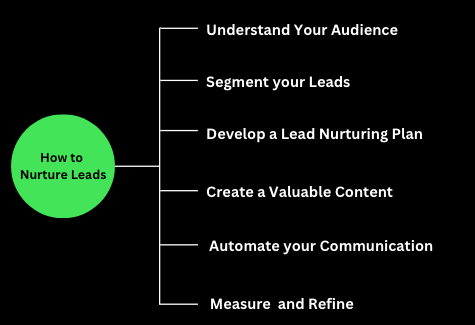
- Understand Your Audience: To effectively nurture leads, you must understand their needs, interests, and pain points. Use tools like customer surveys, website analytics, and social media listening to gather insights and create detailed buyer personas.
- Segment Your Leads: Not all leads are the same, so it’s important to segment them based on factors such as demographics, behavior, and buying stage. This allows you to deliver targeted and personalized content that resonates with each group.
- Develop a Lead Nurturing Plan: Create a plan that outlines your goals, target segments, communication channels, and content strategy. This can include email campaigns, social media engagement, and personalized content such as eBooks, webinars, and whitepapers.
- Create Valuable Content: Develop content that addresses the needs and interests of your target audience at each stage of the buying process. This can include educational content, product demos, case studies, and testimonials.
- Automate Your Communication: Use marketing automation tools to automate your communication and deliver targeted messages based on lead behavior and preferences. This can save time and ensure consistent communication.
- Measure and Refine: Monitor your lead nurturing campaigns and measure key metrics such as open, click-through, and conversion rates. Use this data to refine your approach and optimize your campaigns over time.
How to prepare future strategies of lead nurturing?
As technology and consumer behavior evolve, the future of lead nurturing will likely involve several new strategies and trends. Here is some potential future strategies for lead nurturing:
- Artificial Intelligence: AI-powered chatbots and virtual assistants can provide personalized communication with leads at scale. Businesses can use machine learning to analyze lead behavior and preferences to deliver highly targeted and relevant content.
- Predictive Analytics: Predictive analytics can help businesses to identify leads with the highest likelihood of conversion and deliver targeted communication and content to them. Businesses can optimize their information nurturing efforts and improve their ROI by leveraging data and machine learning.
- Account-Based Marketing (ABM): Account-based Marketing ABM involves targeting high-value accounts with personalized communication and content. This can include creating customized landing pages, personalized email campaigns, and one-to-one interactions with key decision-makers.
- Video Marketing: Video marketing is becoming increasingly popular to engage with leads and deliver value. Businesses can create video content that showcases their products and services, provides educational content, and builds trust with potential customers.
- Omnichannel Nurturing: With consumers using multiple channels and devices to engage with businesses, omnichannel nurturing delivers a consistent and seamless experience across all touchpoints. This can involve integrating email, social media, chatbots, and other communication channels to create a cohesive customer journey.
Benefits of Lead Nurturing
Lead nurturing offers a range of benefits for businesses, including:
Increased Customer Loyalty: Effective lead nurturing can help build long-term relationships with customers, increasing their loyalty and likelihood of recommending the business to others.
Improved ROI: By optimizing lead nurturing efforts and tracking key metrics, businesses can improve their ROI and drive revenue growth.
Better Qualified Leads: By nurturing leads, businesses can better qualify them by identifying those genuinely interested in their products or services, reducing the risk of wasted time and resources.
Greater Brand Awareness: Lead nurturing can help increase brand awareness by delivering targeted and valuable content to potential customers, even if they still need to be ready to purchase.
Example
One example of a brand that has successfully implemented lead nurturing is HubSpot. HubSpot is a marketing, sales, and customer service software provider and has a strong reputation for its lead-nurturing strategies.
HubSpot uses a variety of tactics to nurture leads, including personalized email campaigns, social media engagement, and targeted content such as eBooks and webinars.
They also provide educational resources like blogs and online courses to help potential customers learn more about their products and services.
HubSpot’s lead nurturing approach is focused on delivering value and building relationships with potential customers at each stage of the buying process. By providing personalized and targeted content, they can engage with leads and move them closer to a purchase decision.
Through its lead nurturing efforts, HubSpot has established a strong brand presence and attracted a large and loyal customer base.
In addition, their approach has helped them to improve conversion rates, reduce sales cycles, and drive revenue growth, making them a prime example of effective lead nurturing in action.
FAQs
What is lead nurturing?
Lead nurturing is building relationships with potential customers by providing them with relevant and personalized information at each stage of the buying process.
Why is lead nurturing important?
Lead nurturing is important because it helps increase conversion rates, reduce sales cycles, and build long-term customer relationships. By providing valuable and targeted content, businesses can engage with leads and move them closer to a purchase decision.
How can businesses nurture leads?
Businesses can nurture leads through various tactics, including personalized email campaigns, social media engagement, targeted content such as eBooks and webinars, and one-to-one interactions with key decision-makers.
What are the benefits of lead nurturing?
The benefits of lead nurturing include improved conversion rates, reduced sales cycles, increased customer loyalty, cost-effectiveness, improved ROI, better-qualified leads, and greater brand awareness.
What are some future strategies for lead nurturing?
Future strategies of lead nurturing may include the use of artificial intelligence, predictive analytics, account-based marketing, video marketing, and omnichannel nurturing.
What is the role of technology in lead nurturing?
Technology plays a critical role in lead nurturing, enabling businesses to automate and optimize their efforts.
Technology can help businesses to deliver personalized and targeted content at scale, track key metrics, and improve their ROI.
Interactive Content
Definition
Interactive content is any digital content that allows users to engage and interact with it rather than passively consuming it.
Description
If digital content is not interactive, it risks becoming boring and unengaging for users.
Passive content, such as static text and images, can quickly lose the attention of users accustomed to the dynamic and personalised experiences offered by modern digital technologies.
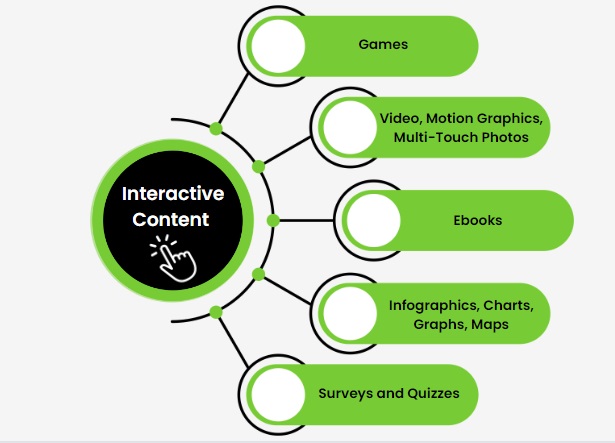
Without interaction, users may gain interest in the content and move on to other sources of information or entertainment. This can lead to lower engagement rates, reduced website traffic, and decreased business conversions.
On the contrary, interactive content provides users with an engaging and personalised experience that encourages them to spend more time interacting with the content and ultimately builds a stronger connection between the user and the brand.
Interactive content can take many forms, including quizzes, polls, games, assessments, surveys, calculators, and interactive videos. Interactive content aims to increase engagement and create a more immersive and personalised experience for the user.
It can be used for various purposes, such as educating and informing users, generating leads, driving conversions, and building brand awareness.
How to generate interactive content?
Generating interactive content can seem daunting, but with the right tools and approach, it can effectively engage your audience and achieve your marketing goals. Here are some steps to follow when generating interactive content:
- Define your goals: Defining your objectives is essential before creating your interactive content. Are you trying to increase engagement, educate your audience, or generate leads? Knowing your goals will help you determine the type of content to create and how to measure success.
- Choose the right format: There are many types of interactive content, including quizzes, polls, surveys, games, and interactive videos. Consider your goals and audience when choosing the format that will be most effective for your message.
- Plan your content: Once you’ve chosen your format, it’s time to plan it. Consider what information you want to convey, the questions you want to ask, and the level of interactivity you want to offer. Consider incorporating multimedia elements such as images, videos, and animations.
- Use interactive content creation tools: Many tools can help you create interactive content, even if you need more technical expertise. For example, Quizlet, Typeform, and Playbuzz offer easy-to-use templates for creating quizzes, polls, and games.
- Promote your content: Once your interactive content is created, it’s essential to promote it through social media, email marketing, and other channels. This will help you reach a wider audience and achieve your marketing goals.
Future Strategy for Interactive Content
The future of interactive content is bright as audiences increasingly demand more engaging and interactive experiences online. Here are some strategies for creating effective interactive content in the future:
- Personalization: Personalization will continue to be an important trend in interactive content, as audiences expect content tailored to their specific interests and preferences. This could include personalised quizzes, interactive product recommendations, and video content.
- Immersive experiences: As technology continues to advance, interactive content will become even more immersive with the use of virtual reality (VR), augmented reality (AR), and other emerging technologies. This could include immersive games, virtual tours, and interactive product demos.
- User-generated content: User-generated content is another significant trend in interactive content, as audiences increasingly want to be part of the conversation. This could include interactive social media campaigns, user-generated quizzes and polls, and collaborative content creation.
- Interactive storytelling: Interactive storytelling is a powerful way to engage audiences and create memorable experiences. This could include interactive videos, choose-your-own-adventure-style content, and interactive e-books.
- Data-driven insights: Businesses can create more targeted and compelling interactive content as they collect more data on their audiences. This could include using data to personalise content, segment audiences, and track engagement.
Benefits of creating an interactive content
There are numerous benefits to creating interactive content, including:
- Increased engagement: Interactive content encourages active participation from audiences, which leads to higher engagement rates than traditional, passive content. This can result in longer dwell times on a website, increased sharing and virality, and heightened brand awareness and advocacy levels.
- Better learning: Interactive content can help audiences learn more effectively by providing a more engaging and immersive experience. For example, interactive videos can help audiences understand complex concepts by allowing them to interact with the content meaningfully.
- Valuable data insights: Interactive content can also provide valuable business data and insights. Polls and surveys can help businesses better understand their audience and preferences, while games and quizzes can provide insights into user behaviour and preferences.
- Increased brand awareness: Interactive content can help businesses improve their brand awareness by creating a more memorable and engaging user experience. This can lead to increased brand loyalty and advocacy.
- Increased conversions: Interactive content can help drive conversions by encouraging audiences to take specific actions, such as filling out a form or purchasing. This can lead to increased sales and revenue for businesses.
Example
One brand example of interactive content is the “Share a Coke” campaign from Coca-Cola. The brand created personalised Coke bottles with customers’ names in this campaign.
In addition, customers were encouraged to share photos of their customised bottles on social media using the hashtag #ShareACoke.
This campaign was successful partly because it was interactive and engaged customers in a fun and personal way. Customers could share their personalised Coke bottles with friends and family on social media, and the campaign went viral.
Coca-Cola also created a website where customers could create virtual Coke bottles with custom messages and share them on social media.
The “Share a Coke” campaign was successful because it incorporated interactive elements that encouraged customers to engage with the brand more personally and meaningfully.
By creating personalised Coke bottles and encouraging customers to share them on social media, Coca-Cola created a more engaging and practical user experience that resonated with customers and helped increase brand loyalty and advocacy.
FAQ
What is interactive content?
Interactive content engages the audience and encourages them to participate in some way. It can take many forms, including quizzes, games, videos, polls, surveys, etc.
Why is interactive content important?
Interactive content is important because it helps to increase engagement with audiences, educates them more effectively, provides valuable data insights, and ultimately drives business results.
What are some examples of interactive content?
Some examples of interactive content include quizzes, videos, games, polls and surveys, and infographics.
How can businesses create interactive content?
Businesses can create interactive content by using interactive content platforms or by hiring content creators with experience in creating interactive content. They can also use interactive content tools and software to create interactive content in-house.
How can businesses measure the effectiveness of interactive content?
Businesses can measure the effectiveness of interactive content by tracking engagement metrics such as clicks, time on page, shares, and conversions. They can also use analytics tools to gather user behaviour and preferences insights.
What are some best practices for creating interactive content?
Some best practices for creating interactive content include keeping it relevant and engaging, providing clear instructions and feedback, making it visually appealing, and optimising it for mobile devices.
What are some trends in interactive content?
Some trends in interactive content include personalization, immersive experiences, user-generated content, interactive storytelling, and data-driven insights.
Hard Bounce
Definition
A hard bounce is an email message returned to the sender because it is permanently undeliverable to the recipient.
Description
A hard bounce is an email message returned to the sender because it is permanently undeliverable to the recipient.
This happens when an email is sent to an invalid or non-existent email address or when the recipient’s email server is blocking the email for various reasons, such as an invalid email account, inactive email account, or a full mailbox.
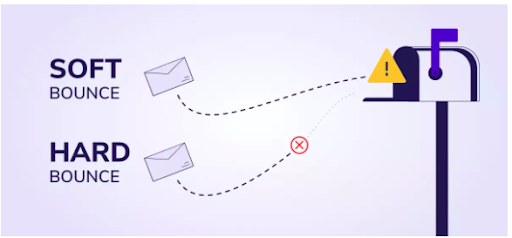
Hard bounces can negatively affect email deliverability and sender reputation, so it’s essential to regularly clean email lists and remove any invalid or inactive email addresses.
Therefore, it is essential for email marketers to regularly clean their email lists and remove any invalid or inactive email addresses to prevent hard bounces and maintain good email deliverability.
Why is it important to find out about Hard Bounce?
Finding hard bounces is essential because:
- They can negatively impact email deliverability and sender reputation.
- When an email message bounces, it indicates to the email server that the recipient address is invalid or non-existent, which can result in the sender being flagged as a spammer.
- This can lead to future emails from the sender being blocked or sent to the recipient’s spam folder, which can significantly reduce the effectiveness of email marketing campaigns.
- Email marketers can improve their deliverability rates and maintain a good sender reputation by identifying hard bounces and removing them from email lists.
How to prevent hard bounce?
Here are some ways to prevent hard bounces:
- Use double opt-in: Double opt-in is a process that requires new subscribers to confirm their email addresses before being added to the mailing list. This helps to ensure that the email address is valid and active, reducing the likelihood of hard bounces.
- Regularly clean email lists: Regularly clean email lists to remove any invalid or inactive email addresses. This can be done by periodically monitoring bounce rates and removing any addresses that have hard bounced.
- Verify email addresses: Verify email addresses before sending emails to ensure they are valid and active. This can be done using email verification services or by sending a confirmation email to new subscribers.
- Use a reputable email service provider: Use a reputable email service provider that has strong email deliverability rates and regularly monitors email lists for bounces and other issues.
- Avoid using purchased email lists: Purchased ones can contain outdated or invalid email addresses, increasing the likelihood of hard bounces. Instead, build your email list through organic methods such as opt-ins and sign-ups.
Benefits to find out hard bounce
There are several benefits to finding out hard bounces:
- Improved deliverability: By identifying and removing hard bounces from email lists, email marketers can improve their deliverability rates and ensure that future emails are more likely to be delivered to the intended recipients.
- Better sender reputation: Hard bounces can negatively impact sender reputation, as they indicate poor list hygiene and can lead to increased bounce rates. By proactively managing email lists and removing hard bounces, email marketers can maintain a good sender reputation.
- Increased engagement: Removing hard bounces from email lists can also help to increase engagement rates, as it ensures that emails are only sent to active and engaged subscribers who are more likely to open, click, and respond to emails.
- Cost savings: Email marketing can be costly, and sending emails to invalid or non-existent email addresses can result in wasted resources and increased costs. By removing hard bounces, email marketers can reduce costs and improve the ROI of their email marketing campaigns.
Example
Delivery to the following recipient failed permanently:
rohan.sharma@abc.in
Technical details of permanent failure: The email account you tried to reach is no longer used. Please check the recipient’s email address and try again.
This is an example of a complex bounce message that indicates that the email was not delivered because the recipient’s email account is no longer in use.
This hard bounce can occur when the recipient has closed their email account or their email service provider has terminated it.
Identifying and removing such email addresses from the mailing list is essential to prevent future hard bounces and maintain reasonable email deliverability rates.
FAQ
What is a hard bounce?
A hard bounce is a permanent failure to deliver an email message to a recipient’s email address. For example, this bounce occurs when the recipient’s email address is invalid, non-existent, or blocked.
What causes a hard bounce?
Hard bounces can be caused by various factors, including invalid or non-existent email addresses, inactive email accounts, email addresses that have been closed or terminated, or email addresses that have been blocked or marked as spam.
Why is it essential to monitor hard bounces?
Monitoring hard bounces is vital for maintaining reasonable email deliverability rates and avoiding potential negative impacts on the sender’s reputation.
By identifying and removing hard bounces from email lists, email marketers can improve their deliverability rates and ensure that future emails are more likely to be delivered to the intended recipients.
How can I prevent hard bounces?
To prevent hard bounces, it is essential to regularly clean email lists, verify email addresses, use a reputable email service provider, avoid using purchased email lists, and use double opt-in processes to confirm the validity of email addresses before adding them to the mailing list.
What should I do if I receive a hard bounce message?
If you receive a hard bounce message, removing the email address from your mailing list and updating your email list hygiene practices to prevent future hard bounces is essential. Contact the recipient to confirm their email address or obtain a new one.
Dynamic Ads
Definition
The personalised and automated advertisements generated in real-time based on a user’s interests, behaviours, and demographics are dynamic ads.
Description
Digital advertising allows marketers to personalise their advertisements in real-time based on the user’s interests, behaviours, and demographics.
These dynamic ads are designed to be highly relevant and engaging to the target audience, resulting in a higher conversion rate.
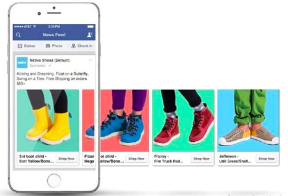
Creating dynamic ads begins with data collection. First, advertisers gather information about the user’s browsing and purchase history, search queries, and other behaviours to develop a profile of their interests and preferences.
This data is then used to create an advertisement tailored to the user’s needs and interests.
Dynamic ads can be delivered through various channels, including social media, display advertising, and search advertising.
For example, an active ad might display a product that a user has recently searched for on a retailer’s website or show a hotel room in a city that the user has expressed an interest in visiting.
Importance of Dynamic Ads
Dynamic ads are essential for several reasons:
- Personalization: Dynamic ads enable advertisers to personalise their content based on the user’s interests, behaviours, and demographics. This helps create a more engaging and relevant experience for the user, increasing the likelihood of a conversion.
- Efficiency: Dynamic ads can be automated, saving advertisers time and resources. Instead of manually creating individual ads for each user, dynamic ads use algorithms and data to generate personalised content in real-time.
- Flexibility: Dynamic ads can be delivered across multiple channels, including social media, display advertising, and search advertising. This allows advertisers to reach their target audience across various platforms, increasing the chances of conversion.
- Cost-effectiveness: Because dynamic ads are personalised and targeted, they are more likely to result in a conversion. This means advertisers can get more value for their advertising budget, which is especially important for smaller businesses.
- Analytics: Dynamic ads provide valuable data on user behaviour, which can be used to improve future campaigns. By analysing the results of dynamic ads, advertisers can identify which strategies are most effective and adjust their approach accordingly.
How to create dynamic ads?
Here are the general steps to create dynamic ads:
- Define your target audience: Determine who you want to target with your dynamic ads based on user behaviour, preferences, demographics, and location.
- Set up your product feed: Create a product data feed that includes all your products and relevant information, such as product IDs, names, descriptions, images, and prices.
- Create your ad templates: Using a dynamic ad platform, create templates that automatically pull in the relevant product data from your product feed and generate personalised product recommendations for each user.
- Set up your ad campaigns: Set up your campaigns in the platform, specifying details such as targeting criteria, budget, bid strategy, and ad format.
- Launch and optimise your campaigns: Launch your campaigns and monitor their performance to identify opportunities to optimise your ad templates, targeting criteria, and bidding strategy for better results.
Future of Dynamic Ads when there exists Ad Fatigue
Ad fatigue is a common issue that advertisers face when running digital campaigns, including dynamic ads.
Ad fatigue occurs when users become desensitised to ads due to overexposure or repetitive messaging, which can result in lower engagement and conversion rates.
To address ad fatigue in the context of dynamic ads, advertisers can take several approaches:
- Rotate Ad Content: One approach is periodically rotating the ad content to keep it fresh and engaging for users. This can involve changing the ad copy, images, or targeting parameters to create a new experience for the user.
- Frequency Capping: Another approach is to set frequency caps on the number of times a user sees a particular ad. This can help to prevent overexposure and reduce the risk of ad fatigue.
- Diversify Ad Formats: Advertisers can also experiment with different ad formats, such as video, carousel ads, or interactive ads, to provide a varied and engaging experience for the user.
- Focus on Quality Over Quantity: Advertisers should focus on creating high-quality ads that are relevant, engaging, and valuable to the user. By creating ads that provide value to the user, advertisers can reduce the risk of ad fatigue and build stronger relationships with their target audience.
Things To Keep In Mind While Creating Dynamic Ads
Here are some things to keep in mind while creating dynamic ads:
Data Collection: The success of dynamic ads relies heavily on the quality and accuracy of the data used to create them.
Collecting and analysing data from various sources, including website analytics, Customer Relationship Management (CRM) data, and social media engagement, is important to create a complete picture of the user’s interests and behaviours.
- Relevance: Dynamic ads should be highly relevant to users’ interests and needs. Ensure the ad content is personalised and tailored to the user’s profile, including past purchases, search history, and preferences.
- Visual Appeal: Dynamic ads should be visually appealing and eye-catching. Use high-quality images and graphics, and make sure the ad is easy to read and understand.
- Ad Copy: Ad copy should be concise, clear, and persuasive. Highlight the key benefits of the advertised product or service, and use language relevant to the user’s interests and needs.
- Call-to-Action: Include a clear and compelling call-to-action (CTA) in the ad, encouraging the user to take action, such as purchasing or visiting a website.
- Testing: Optimising your dynamic ads is important to ensure maximum effectiveness. Test different ad variations, targeting parameters, and messaging to identify the most effective strategies for your target audience.
Example
Myntra, one of India’s leading online fashion and lifestyle stores, uses dynamic ads to promote its products to customers based on their browsing history and purchase behaviour.
For example, if a customer has been browsing for shoes on Myntra, the brand might show them dynamic ads featuring similar or complementary products, such as bags or accessories.
By using dynamic ads, Myntra can personalise its advertising content and make it more relevant to each customer, increasing the chances of a conversion.
FAQ
What are dynamic ads?
Dynamic ads are a type of digital advertising that uses data and algorithms to create personalised and relevant content for each user. They can be used across various platforms, including social media, display advertising, and search advertising.
How do dynamic ads work?
Dynamic ads use user data, such as browsing history, search behaviour, and demographic information, to create personalised content. Algorithms and automation tools are used to generate ad content in real-time, making it more efficient and cost-effective for advertisers.
What are the benefits of dynamic ads?
Dynamic ads offer several benefits, including personalization, efficiency, flexibility, cost-effectiveness, and valuable data analytics. By using data to create targeted content, advertisers can increase engagement, conversions, and ROI.
What are the best practices for creating dynamic ads?
Best practices for creating dynamic ads include collecting quality data, creating relevant and visually appealing ad content, using persuasive ad copy, including a clear and compelling call-to-action, and testing and optimising ad content to identify the most effective strategies.
How can advertisers avoid ad fatigue with dynamic ads?
Ad fatigue can be a challenge with dynamic ads. Still, advertisers can address it by rotating ad content, setting frequency caps, diversifying ad formats, focusing on quality over quantity, and creating high-quality, engaging content relevant to the user.
What types of businesses can benefit from using dynamic ads?
Any business looking to increase engagement, conversions, and ROI can benefit from dynamic ads. This includes e-commerce businesses, retailers, travel companies, and service providers.
Customer Data Platform
Definition
A customer data platform (CDP) is a software platform designed to collect, unify, and manage customer data from multiple sources in a centralised location.
Description
Personalising customer experience is important for businesses to beat the competition.
A CDP enables companies to comprehensively view their customer’s behaviour, preferences, and interactions across various channels, such as websites, mobile apps, social media, email, and offline touchpoints.
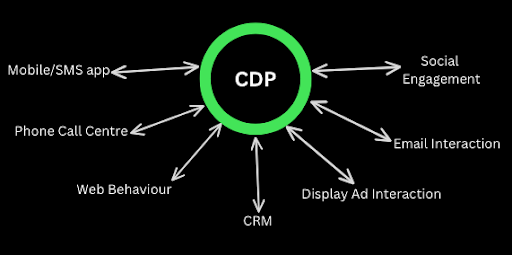
CDPs use various data sources, such as customer relationship management (CRM) systems, marketing automation tools, e-commerce platforms, social media platforms, and third-party data providers, to create a unified customer profile.
The profile includes customer demographic information, browsing history, purchase behaviour, and other relevant data points.
Importance of CDP
Customer data is essential for businesses to understand customers’ needs, preferences, and behaviour.
With a centralised platform to collect and manage customer data, companies understand their customers comprehensively, resulting in missed opportunities for personalised experiences and improved customer engagement.
Here are some of the key reasons why a CDP is important for businesses:
- Consolidates customer data: A CDP consolidates customer data from various sources into a centralised location. This enables businesses to comprehensively view their customers and their interactions across multiple channels.
- Provides a unified customer profile: A CDP creates a unified customer profile that includes data on customer demographics, behaviour, preferences, and interactions. This provides a holistic view of the customer and enables businesses to deliver personalised experiences and targeted marketing campaigns.
- Improves customer engagement: By using the insights gained from a CDP, businesses can better understand their customers and deliver personalised experiences that resonate with them. This can lead to increased engagement, loyalty, and retention.
- Enables data-driven decision-making: A CDP provides insights into customer behaviour and preferences, which can be used to inform business decisions, product development, and marketing strategies. This enables businesses to make data-driven decisions based on a deep understanding of their customers.
- Increases operational efficiency: By consolidating customer data into a single platform, a CDP can improve operational efficiency by reducing the time and resources needed to manage customer data across multiple systems.
How do Customer Data Platform (CDP) collect data?
CDPs typically use a variety of methods to collect and ingest data, including:
- API connections: CDPs can use application programming interfaces (APIs) to connect to other systems and collect data automatically. For example, a CDP can use APIs to collect data from a company’s CRM, marketing automation platform, or e-commerce platform.
- Batch uploads: Companies can upload data files to a CDP regularly. This can include customer lists, transactional data, or other data types.
- Tagging and tracking: CDPs can use tags or tracking codes to collect data from a company’s website or mobile app. This can include data on customer behaviour, such as page views, clicks, or conversions.
- Data connectors: CDPs can use pre-built data connectors to external data sources, such as social media platforms, advertising networks, or data brokers.
What are the sources from which Customer Data Platform collects data?
- First-party data: This is data that a company collects directly from its customers. For example, a CDP can collect customer data from a company’s website, mobile app, point-of-sale system, or customer service interactions.
- Second-party data: This is data that a company obtains from another organisation that has collected the data directly from its customers. For example, a company may purchase data from a partner that has collected data on a specific demographic or audience.
- Third-party data: This is data that a company obtains from external data providers, such as data brokers. Third-party data can include demographic, behavioural, and transactional data.
Future changes expected in Customer Data Platform (CDP)
Customer Data Platforms (CDPs) are constantly evolving to meet the changing needs of businesses and customers. Here are some of the future changes that we can expect in CDP:
- Enhanced AI and machine learning capabilities: CDPs will continue to improve their AI and machine learning capabilities to help businesses gain deeper insights into their customers. This will enable more personalised experiences and more effective targeting of marketing campaigns.
- Greater focus on privacy and data protection: With increased concerns over data privacy and security, CDPs will need to emphasise privacy and data protection more. This may include stronger encryption, more robust access controls, and other measures to protect customer data.
- Integration with emerging technologies: CDPs must integrate with emerging technologies, such as voice assistants, chatbots, and augmented reality, to provide seamless customer experiences across multiple channels.
- Real-time data processing: CDPs must improve their real-time data processing capabilities to provide businesses with up-to-the-minute insights into customer behaviour and preferences. This will enable businesses to respond quickly to changing customer needs and preferences.
- Greater emphasis on data quality: As the volume of customer data grows, CDPs will need to emphasise data quality more. This may include automated data validation, cleaning, and other measures to ensure data accuracy and reliability.
Benefits of Customer Data Platform
A Customer Data Platform (CDP) is a software system that collects, unifies and manages customer data from various sources, such as CRM systems, website interactions, social media, email marketing, and more.
CDPs help businesses comprehensively understand their customers and leverage that knowledge to improve their marketing, customer service, and overall customer experience. Here are some of the benefits of a CDP:
- Unified customer data: CDPs consolidate customer data from multiple sources, providing a unified view of customer behaviour and preferences. This enables businesses to understand customer interactions across channels and touchpoints.
- Enhanced customer experiences: With a better understanding of customer behaviour and preferences, businesses can personalise their marketing and customer service efforts, creating a more engaging and relevant customer experience.
- Improved marketing effectiveness: CDPs can help businesses optimise their marketing campaigns by providing insights into which channels and messages are most effective for customer segments.
- Better customer segmentation: CDPs can help businesses segment their customers based on various criteria, such as demographics, behaviour, and preferences. This enables businesses to create targeted marketing campaigns and personalised experiences for each segment.
- Data privacy compliance: CDPs help businesses comply with data privacy regulations by providing a centralised platform to manage customer data and ensure data security.
Example
Flipkart, India’s largest e-commerce company, uses a CDP to collect and manage customer data across multiple channels.
The CDP enables Flipkart to create a unified customer profile that includes data on customer demographics, behaviour, preferences, and interactions.
This allows Flipkart to deliver personalised experiences and targeted marketing campaigns that drive engagement and loyalty.

Flipkart’s CDP collects data from multiple sources, including customer transactions, website interactions, and mobile app usage.
The CDP uses machine learning and other techniques to process and unify the data, providing Flipkart with a holistic view of its customers.
Using the insights gained from its CDP, Flipkart can offer personalised product recommendations, targeted promotions, and other features that improve the customer experience.
This has helped Flipkart to maintain its position as India’s leading e-commerce company and drive continued growth in the highly competitive Indian market.
FAQ
What is a Customer Data Platform (CDP)?
A Customer Data Platform is a software platform that allows businesses to collect and manage customer data from multiple sources and create a comprehensive customer profile that can be used to personalise the customer experience.
What are the benefits of using a CDP?
Some benefits of using a CDP include: gaining a comprehensive understanding of customers, creating personalised experiences, improving customer engagement and loyalty, and driving revenue growth.
What types of data can a CDP collect?
A CDP can collect a wide range of data types, including demographic data, transactional data, website and mobile app usage data, social media data, and more.
How does a CDP differ from other customer data management tools?
A CDP is specifically designed to collect and unify customer data from multiple sources and create a comprehensive customer profile. Other customer data management tools, such as CRMs or marketing automation platforms, may focus on specific aspects of customer data management.
Is a CDP only useful for large businesses?
No, businesses of all sizes can benefit from using a CDP. Small and medium-sized businesses can use a CDP to better understand their customers and deliver personalised experiences, just like larger businesses.
How does a CDP ensure data privacy and security?
A CDP can ensure data privacy and security by implementing encryption, access controls, and other security protocols. Additionally, many CDPs are compliant with data privacy regulations, such as GDPR and CCPA.
How much does a CDP cost?
The cost of a CDP can vary depending on the specific platform and the business size. Some CDPs offer tiered pricing based on the number of contacts or data volume, while others offer custom pricing based on the business’s specific needs.
How can businesses integrate a CDP into their existing systems?
CDPs typically offer integrations with a wide range of marketing automation, CRM, and other systems. Depending on the specific CDP and integrated systems, integration can be done through APIs, batch uploads, or other methods.
Landing Page
Definition
Landing page is a standalone page created for marketing or advertising.
Description
You want to bring visitors to your website and inform them about your page in as much detail as possible. The intent is to make the visitors aware of how you can benefit them.
And for this purpose, taking the visitors to the landing page is the ultimate goal.
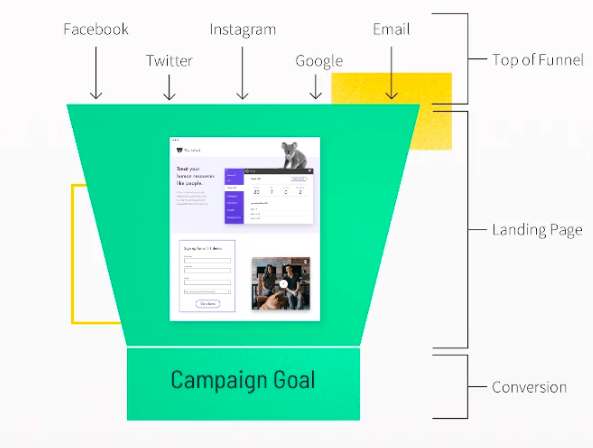
The picture shows that the landing page exists after the top of the funnel where the users click the link after they visit social media pages or any email link.
In a content strategy, it help to convert more traffic and increase conversions. The average conversion rate is 4.06% with it as observed in 2019.
The page conversion refers to the percentage of people who completed call-to-action and landed on the page.
Another study by Unbounce derived that the average landing conversion rate is 4.02% across 10 different industries that had more than 74 lakhs visitors on the landing pages.
It has fewer links that increases conversion rate which is why the expert marketers create a landing page. A normal home page is different from a landing page as it has more than one CTA.
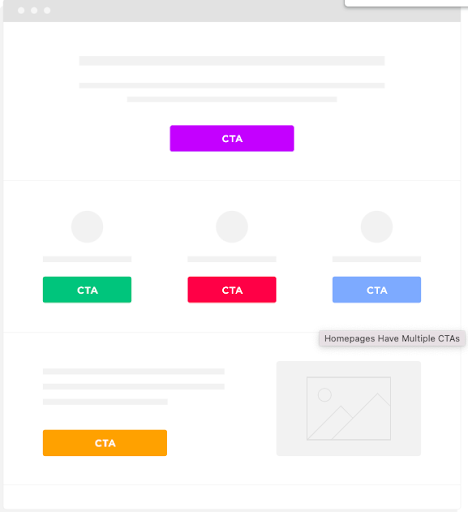
Home page has multiple goals and for that it has multiple CTA. On the other hand, it has one goal and it has one CTA.
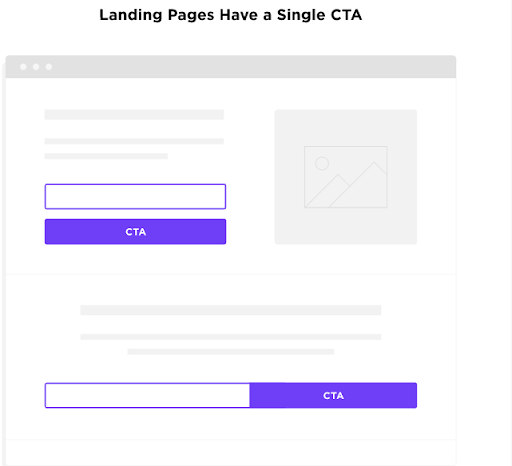
These are considered important and help in higher conversion because they are:
- Built with a focused CTA.
- They are targeted to a specific group.
- It is not important to have a website to host landing pages.
- It is fine to have multiple landing pages. You can have different pages for each campaign.
- Landing pages are for the purpose of marketing and advertising
Example

This is a screenshot of Lakme’s landing page. The page displays cosmetic products from Lakme alone. The page looks awesome because:
- It has a compelling tagline “You draw the line”.
- It has a clear CTA.
- It has a clear image and impressive product description.
- The social media presence on the bottom right corner gives confidence to the customers telling them the brand representatives are available for quick chat.
Importance of Landing Page
These are a way for lead conversion and hence it is important to have one.
You can have leads by observing the number of visitors to your site but not all leads get converted. This is where a landing page plays its role.
- Encourage visitors to take more actions. This is from where the lead generation takes it to actual sales.
- Can improve SEO and build your brand.
- Can form a part of an effective PPC strategy.
Things that make a landing page good
Observing an improvement in the conversions with an ever larger email subscribers list? It could be with the right landing page. A right page can capture the attention of the visitor. This is how you can make it good:
- Make the offer compelling: You don’t have to be salesy! Stick to making the offer compelling. Once the visitors find the offer attractive they are more likely to click on it. Don’t make a long history on the landing page instead just make it specifically for goals you want to achieve.
- Focus on the end goal: The content on this page should match the end goal. It should allow the user to register if they want.
- Keep the forms short and crisp: Keep the forms short. The idea is to keep the visitors engaged for long and encourage them to provide correct information. Break the form into two if you feel that information is much needed.
- Speak to specific audience: Target the specific audience with the custom campaigns. Provide information on a particular offer for which the audience was driven like for an eBook or discount.
- Collect the right information in the form: Collect the right demographics and details about the specific audience.
- Follow up with a Thank You Page: Make sure that the landing page should be followed by a polite Thank You Page.
- Provide links to other offers: After giving your customers what you have offered, you can also provide links to other offers or your social media profiles.
Best Practices of Creating a Landing Page
Grabbing customer’s attention is the main punch of creating a landing page. These are the best practices of creating a landing page:
- Make sure that headlines and call-to-action lie in one fold: Place the headline and call-to-action in the top fold of the landing page. One fold here refers to the screen visible without scrolling down. Keeping the headlines and CTA here increases the chances of conversion. For SEO purposes, the headline must be compelling and it should include the main keyword.
- Use one CTA: One landing page should be optimised for one goal. Keep one CTA which could be downloading an eBook, contest alert, registration, etc. Too many CTAs can confuse the visitor.
- Repeat the CTA: Repeat the call-to-action if need be. You can repeat the CTA in bottom scrolls also making it easy for the visitors.
- CTA button colour: CTA button colour on the landing page should be of contrast colour so that it catches attention of the users.Keep the repeated CTA of same design and colour.
- Design for mobile: Approximately 58% of traffic comes from mobile hence making a mobile-friendly landing page is important.
- Use Testimonials: Words have the power to spread both good and bad for you. If you have testimonials or reviews, you can post them on the website. It helps to build brand trust and credibility.
- Use videos: Words help to explain to the users what you do but videos are there to cement the bond better. It can be an opportunity to connect with the audience and communicate about the brand.
- Quality content: Keep the content of high quality and make it compelling with words like “you get”, “you feel”, and “have”.
FAQs
What are the five essential elements of a landing page?
These are the five essential elements of a landing page:
- Clear unique selling proposition (USP)
- Engaging hero shot
- Compelling benefits
- Strong Call-To-Action
- Social Proofs
What is the difference between a Homepage and a Landing Page?
Following is the difference between a homepage and a landing page:
| Home Page | Landing Page | |
|---|---|---|
| Objective | The homepage takes directly to relevant content. | On the other hand, it delivers request content. The request was made by clicking on the CTA link. |
| Traffic Source | Varied | Specific |
| Content | The home page has an overall business category and positioning copy. | It on the other hand is specific to benefits of the desired CTA. |
| Action | The home page draws a visitor deeper into the website. It gives information about the site in detail. | On the other hand, a it takes a specific action. |
| Navigation | Complete range of options as on website. | Minimal. |
How many landing pages should you have?
Research shows that websites should have 10 to 15 landing pages. It gives a 55% boost in traffic conversion.
Where should I place landing pages?
Often people host their landing pages on their website, but it is not essential to have a website for the landing page. For each campaign, you need a different landing page.
H Tags
Definition
H Tags or Header tags are heading that are used to separate headings and subheadings on a webpage.
Description
High relevant content is posted first on a blog page or a website. Considering that the important information catches more attention, it is placed higher to keep the user engaged with the content. This is where heading helps to classify the content.
The header tags separate the content and they rank in order of importance H1 to H6. Header tags improve the readability of a webpage. It is also important for SEO perspective that it affects the ranking on Google SERP.
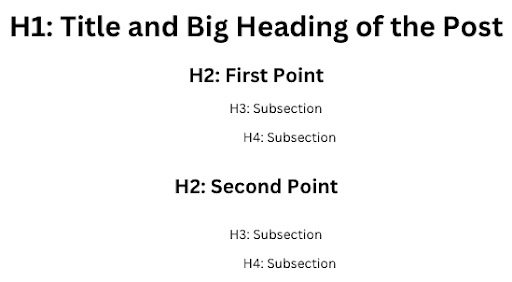
This is how you can understand the header tag:
H1: The title of the post. The header should be keyword oriented improving its probability for higher ranking. Also H1 is the title so it grabs more attention of the readers.
H2: The subheaders under the main paragraph are H2. The header can accommodate semantic keywords in H2 to give readers ideas on what they want to read.
H3: The header 3 further clarifies the sub-sections under H2. The header can be used to format bullets and lists under H2.
H4: Sub-sections under H3 are referred to as H4. These headings clarify the lists and bullets under H3.
Each tag defines a hierarchical relationship between the two. Putting a header tag signifies that you are signalling that the text is important.
And Google can use the header to determine the context of the page which helps to rank the page and show it in SERP.
Example
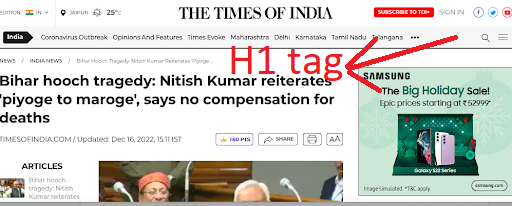
H1 is an HTML tag that identifies the first heading of the page. The header tag gives the name of the page or the publication. In this case, it will be “The Time of India” as H1 that gives the name of the publication.
Importance of Header Tags
A header tag is important:
- For SEO purposes as it tells the reader as well as the search engine what the article is about and why they should read it.
- A header tag helps the article appear frequently when the article is searched for. It increases the website traffic.
- Header tags make browsing fast and reading the article easier for the readers. The tag engages the audience more because they can find from the heading whether the article will serve them the content they are looking for.
How to Add a Header Tag in HTML?
This is how you can add a header tag in HTML:
Suppose you want to add an H1 tag, so notate “<h1>” and “</h1>” and now put the H1 tag in between these two tags.
So, if the h1 is “ Do the Digit Insurance”, it is added like this in the code
<h1> to </h1>

And like this on the page
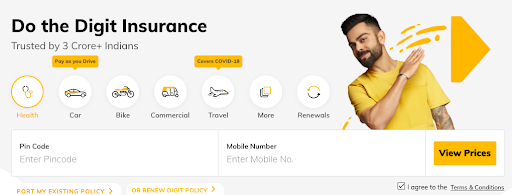
Similarly, you can add other header tags as well to include h2, h3, and so on.
Best practices for H1 header tag
These are the tips to create the best H1 tag:
- Use only one H1 tag on the page: You can make only one heading as important as H1 and catch the user’s attention easily. For subsequent heading, use H2 tags and henceforth. It distinguishes the relevance of the content.
- Link the subject and the essence of the page with H1 tag: The H1 title should reflect the essence of the content. It should contextually indicate the same meaning for which it will be searched and ranked for in search engines.
- H1 tag should express the same idea: The two tags cannot be the same but they can express the same idea. H1 tag can be longer than the title tag(which is seen on the SERP). H1 tag has to be user-friendly and focus more on user experience.
- Use Keywords: One of the most common practices for H1 tags is to use keywords. Avoid oversaturating the heading. Instead, you can use the long tail keywords for the same.
- Don’t make headlines too long: Headlines bigger than 30-60 characters are acceptable for Google but beyond that it goes complex. Keep it short for users to remain interested in the content.
- Focus on the interest of the user: Analyse the purpose for which the content is created. Remember that you are serving the content to the user and you have to keep them on the site for the longer.
FAQs
What is the difference between H1 and Title Tag?
The Title Tag is displayed on SERP which is the text that the users will see on search engines. It is a name for the hyperlink of the page. On the other hand, H1 tag marks the heading that users can see on the site as the name of the publication.
What are the SEO tips for H1 Tag?
These are the SEO tips for H1 tag:
- Always include the H1 tag. It helps search engines find your content.
- Use only one H1 tag per page
- Include primary keywords but avoid stuffing more than one keyword. The highest volume and critical keywords are used in the Title tag. The next best is used in the H1 tag.
- Use up to 70 characters tag length.
How to optimise header tags?
Optimising heading tags help you from a SEO point of view. These are the tips you can follow to optimise the header tags:
- Use only one <h1> tag
- Keep the hierarchy correct from <h1> to <h6>
- Apply keywords within the headings. Choose keywords based on the search volume.
- Don’t overuse the H tags.
- Don’t overstuff the keywords in the header tags.
- Keep the styles clear and format headings within CMS to avoid unexpected / extra symbols within the tags.
Guerilla Marketing
Definition
Guerilla marketing is a marketing strategy involving unconventional and creative tactics to cost-effectively promote a product, service or brand.
Description
Businesses often use guerilla marketing because it can be a cost-effective way to reach a target audience and generate buzz around a product, service or brand.
It offers a creative and unconventional approach to marketing that can stand out from traditional methods, which can be oversaturated and ignored by consumers.

Guerilla marketing campaigns can also be highly shareable on social media, further amplifying their reach and impact. Additionally, guerilla marketing allows for greater flexibility and agility, enabling businesses.
Identifying and targeting a specific audience through unexpected and memorable experiences, such as street performances, flash mobs, or viral social media campaigns, to generate buzz and word-of-mouth publicity.
Guerilla marketing aims to create a lasting impression and engage consumers in a unique and meaningful way that traditional marketing methods may not achieve.
Importance of Guerilla Marketing
Guerilla marketing can be important for businesses in several ways:
- Cost-effective: Guerilla marketing can be a cost-effective alternative to traditional advertising methods, such as television or print advertising, which can be expensive. Guerilla marketing campaigns often rely on creativity and unconventional tactics, rather than large budgets, to reach their target audience.
- Creates buzz: Guerilla marketing campaigns often generate buzz and excitement among consumers, increasing brand awareness and sales. Using creative and unexpected tactics, guerilla marketing can capture consumers’ attention and generate word-of-mouth publicity.
- Targets specific audiences: Guerilla marketing allows businesses to target particular audiences uniquely and meaningfully. By tailoring campaigns to specific demographics, businesses can create a more personal and memorable experience for their target audience.
- Enhances brand identity: Guerilla marketing can help businesses establish and improve their brand identity by creating a distinct and memorable impression on consumers. By using unconventional and creative tactics, businesses can differentiate themselves from their competitors and establish a unique identity in the minds of consumers.
- Flexibility and adaptability: Guerilla marketing campaigns can be highly flexible and adaptable, allowing businesses to quickly respond to changing market conditions and consumer trends. This can be especially important in fast-paced industries where businesses must stay ahead of the competition.
How to make a strategy for Guerilla Marketing?
Here are some steps to create a guerilla marketing strategy:
- Define your objectives: Determine what you want to achieve through your guerilla marketing campaign. This could be increasing brand awareness, generating leads, boosting sales, etc.
- Identify your target audience: Identify the audience you want to reach through your guerilla marketing campaign. This could be a specific demographic, location, or interest group.
- Brainstorm creative ideas: Brainstorm unique and innovative ideas that will capture the attention of your target audience. Consider using unexpected locations, interactive experiences, or viral social media campaigns.
- Evaluate feasibility: Evaluate the feasibility of each idea based on your available resources, budget, and time frame. Choose the ideas that are most feasible and align with your objectives.
- Develop a plan: Develop a detailed plan for executing your chosen ideas. This should include timelines, budgets, logistics, and responsibilities.
- Execute the campaign: Execute your guerilla marketing campaign according to your plan. Be prepared to adapt and adjust your strategy based on feedback and results.
- Measure success: Measure the success of your campaign based on your objectives. This could include metrics such as website traffic, social media engagement, or sales. Use this data to evaluate the effectiveness of your guerilla marketing strategy and make adjustments for future campaigns.
Future of Guerilla Marketing Tactics
The future of guerilla marketing looks promising as it continues to evolve and adapt to changes in consumer behaviour and technology. Here are some potential trends and developments for the future of guerilla marketing:
- Increased use of technology: As technology continues to advance, guerilla marketing campaigns may incorporate more digital and immersive experiences, such as virtual reality or augmented reality.
- Personalization: Guerilla marketing may become more personalised as businesses use data and analytics to tailor campaigns to individual consumers.
- Integration with social media: Social media has become a key component of guerilla marketing, and this trend is likely to continue as businesses leverage social media platforms to amplify their campaigns and generate user-generated content.
- Sustainability: As consumers become more environmentally conscious, guerilla marketing campaigns may incorporate sustainability as a key theme or message.
- Greater focus on experiential marketing: Experiential marketing, which involves creating immersive and interactive experiences for consumers, may become more prominent in guerilla marketing as businesses seek to engage audiences in more meaningful ways.
Example

Amul is a dairy cooperative in India known for its creative and unconventional marketing campaigns.
One notable guerilla marketing campaign by Amul involved placing life-sized cutouts of the Amul girl mascot in unexpected locations, such as outside government offices or popular tourist attractions.
FAQ
What is guerilla marketing?
Guerilla marketing involves unconventional and creative tactics to promote a product or service. It typically relies on low-cost or no-cost methods and aims to create a high impact on consumers.
What are some examples of guerilla marketing tactics?
Some examples of guerilla marketing tactics include flash mobs, street art, pop-up shops, interactive installations, and viral social media campaigns.
Is guerilla marketing effective?
Guerilla marketing can be very effective if done correctly. It allows businesses to stand out from their competitors, creates a memorable impression on consumers, and generates buzz and word-of-mouth promotion.
What are the advantages of guerilla marketing?
The benefits of guerilla marketing include cost-effectiveness, high impact, word-of-mouth promotion, and targeted marketing.
What are the risks of guerilla marketing?
The dangers of guerilla marketing include legal issues, adverse reactions from consumers or authorities, and potential damage to the brand’s reputation.
How can I create a guerilla marketing campaign?
To create a guerilla marketing campaign, businesses should define their objectives, identify their target audience, brainstorm creative ideas, evaluate the feasibility, develop a plan, execute the campaign, and measure success.
What is the future of guerilla marketing?
The end of guerilla marketing will likely involve greater use of technology, more personalised campaigns, increased integration with social media, and a greater focus on sustainability and experiential marketing.
Go to Market Strategy
Definition
A go-to-market (GTM) strategy refers to a business’s plan and actions to bring its product or service to market and acquire customers.
Description
The GTM strategy typically includes identifying the target market, defining the value proposition, setting the pricing strategy, determining the distribution channels, developing the marketing and sales tactics, and analysing the competition.
A well-defined GTM strategy can help a business launch its product or service effectively, reach the right audience, and generate revenue.
A go-to-market (GTM) strategy is an essential business process that defines how a company will bring its products or services to market and reach its target customers.
It is a comprehensive approach that covers all aspects of product development, marketing, sales, and distribution.
The main components of a GTM strategy typically include the following:
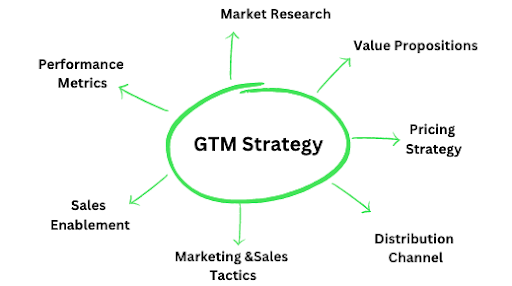
- Market Research: Understanding the target market, customer needs, and market trends are critical to developing a successful GTM strategy.
- Value Proposition: The unique selling points of a product or service and how it solves a customer’s problem or meets their needs.
- Pricing Strategy: Determining the price point that is competitive, profitable, and aligned with customer expectations.
- Distribution Channels: Identifying the most effective channels to distribute the product or service to the target audience, whether direct sales, partnerships, or online marketplaces.
- Marketing and Sales Tactics: Creating a comprehensive plan to promote the product or service, including advertising, content marketing, social media, email campaigns, and more.
- Sales Enablement: Equipping the sales team with the necessary tools and training to sell the product or service effectively.
- Performance Metrics: Measuring the success of the GTM strategy through key performance indicators (KPIs), such as sales revenue, customer acquisition, retention, and market share.
A well-crafted GTM strategy can help businesses create a competitive advantage, maximise customer engagement, and increase revenue. It also provides a roadmap for continuous improvement and refinement of the sales and marketing process.
Importance of Go-to-Market Strategy
A go-to-market (GTM) strategy is crucial for the success of any business that wants to bring a product or service to market. Here are some of the key reasons why a well-defined GTM strategy is so important:
- Aligns Business Goals: A GTM strategy helps align the company’s goals with its marketing and sales objectives. It provides a roadmap for launching and promoting products or services to the target audience.
- Identifies Target Market: A GTM strategy helps identify the target market, including its needs, preferences, and behaviour. This information enables businesses to develop effective marketing and sales tactics to engage the target audience.
- Defines Unique Value Proposition: A GTM strategy defines the unique value proposition of the product or service, which helps differentiate it from competitors. This is critical for creating a competitive advantage in the market.
- Optimises Resource Allocation: A GTM strategy helps optimise the allocation of resources, including budget, time, and talent. It ensures that these resources are focused on the most effective marketing and sales tactics to achieve business objectives.
- Enables Continuous Improvement: A GTM strategy provides a framework for ongoing analysis and refinement of marketing and sales tactics. This helps businesses to continuously improve their approach and increase the effectiveness of their GTM strategy.
- Facilitates Decision Making: A GTM strategy provides the information and insights to make informed decisions about product development, pricing, distribution, and marketing.
How to prepare a Go-to-Market strategy?
Preparing a go-to-market (GTM) strategy requires a comprehensive approach that covers all aspects of product development, marketing, sales, and distribution. Here are the general steps for preparing a GTM strategy:
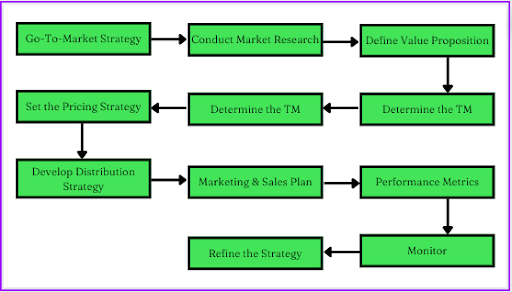
- Conduct Market Research: This involves researching the target market, customer needs, and market trends to better understand the competitive landscape and potential demand for the product or service.
- Define the Value Proposition: This involves identifying the unique selling points of the product or service, how it solves a customer’s problem or meets their needs, and how it differs from competitors.
- Determine the Target Market: This involves identifying the specific customer segments for which the product or service is intended and creating customer personas to guide marketing and sales efforts.
- Set the Pricing Strategy: This involves determining the optimal price point that is competitive, profitable, and aligned with customer expectations.
- Develop the Distribution Strategy: This involves identifying the most effective channels to distribute the product or service to the target audience, whether through direct sales, partnerships, or online marketplaces.
- Create the Marketing and Sales Plan: This involves developing a comprehensive plan to promote the product or service, including advertising, content marketing, social media, email campaigns, and more. It also equips the sales team with the necessary tools and training to sell the product or service effectively.
- Establish Performance Metrics: This involves defining key performance indicators (KPIs) to measure the success of the GTM strategy, such as sales revenue, customer acquisition, retention, and market share.
- Continuously Monitor and Refine the Strategy: This involves regularly reviewing and analysing the performance metrics to identify areas of improvement and refining the GTM strategy accordingly.
Future of Go-to-Market Strategy
The business world constantly evolves, and the go-to-market (GTM) strategy is no exception. Here are some of the future trends that are expected to impact the GTM strategy:
- Personalization: As customers demand more personalised experiences, GTM strategies must focus on developing targeted marketing and sales approaches that resonate with individual customer needs and preferences.
- Digitalization: With the rise of digital channels, GTM strategies must adapt to reach customers through online marketplaces, social media, and other digital platforms.
- Sustainability: As consumers become more conscious of sustainability and ethical considerations, GTM strategies must emphasise environmentally-friendly products and practices to meet customer demands.
- Integration: GTM strategies must integrate all aspects of the customer journey, from product development to post-sale support, to create a seamless and satisfying customer experience.
- Data Analytics: With the increasing availability of data and analytics tools, GTM strategies must leverage these insights to make informed decisions about product development, pricing, distribution, and marketing.
- Artificial Intelligence: Artificial intelligence (AI) is expected to play an increasingly important role in GTM strategies, with AI-powered chatbots and other tools helping streamline customer support and enhance the overall customer experience.
- Collaboration: GTM strategies will need to emphasise cooperation across teams and departments to ensure that all aspects of the business are aligned with the GTM objectives.
Benefits of Go-to-Market Strategy
A well-executed go-to-market (GTM) strategy can bring numerous benefits to a business, including:
- Faster Time to Market: A GTM strategy ensures that a product or service is launched efficiently, reducing the time to market and enabling the business to capitalise on market opportunities quickly.
- Competitive Advantage: A GTM strategy helps businesses stand out by differentiating their product or service and emphasising their unique value proposition.
- Improved Sales: A GTM strategy provides a roadmap for reaching target customers, identifying the most effective sales channels, and creating targeted marketing campaigns, increasing sales and revenue.
- Greater Customer Satisfaction: A GTM strategy helps businesses better understand their target customers, develop products that meet their needs, and deliver a positive customer experience, resulting in higher customer satisfaction and loyalty.
- Increased Market Share: A GTM strategy enables businesses to gain a more significant market share by identifying and targeting underserved customer segments and creating products and services that meet their needs.
- Cost Efficiency: A GTM strategy helps businesses optimise their marketing and sales efforts, reducing costs and improving profitability.
- Improved Agility: A GTM strategy enables businesses to respond quickly to market, or customer needs changes by providing a framework for decision-making and adaptability.
Example
Apple is well-known for its successful go-to-market (GTM) strategies, and the launch of the iPhone in 2007 is a prime example. Apple’s GTM strategy for the iPhone was based on several key elements.
First, they focused on product differentiation, emphasising the iPhone’s sleek design, intuitive user interface, and advanced features such as a high-quality camera and touch screen.
Second, Apple targeted a specific market of tech-savvy consumers who valued innovation and design. Third, their marketing efforts emphasised the iPhone’s unique features and benefits, such as its ability to surf the internet and play music.
Third, Apple launched the iPhone exclusively through AT&T in the United States, creating a sense of exclusivity and scarcity that helped generate buzz and demand for the product.
Fourth, Apple priced the iPhone higher than other smartphones on the market, positioning it as a premium product that offered superior value to consumers who valued innovation and design.
Finally, Apple partnered with third-party app developers to create a robust app store that offered a wide range of apps and games, which helped to increase the iPhone’s appeal and usability.
Overall, Apple’s GTM strategy for the iPhone was highly influential, generating significant buzz and demand for the product and helping to establish Apple as a leading player in the smartphone market.
FAQs
Why is a go-to-market strategy important?
A go-to-market strategy is essential because it helps a company to effectively target and reach its intended customers, differentiate itself from competitors, and maximise its chances of success in the marketplace.
What are the critical components of a go-to-market strategy?
The key components of a go-to-market strategy typically include identifying the target market and customer segments, defining the value proposition and messaging, determining the sales and distribution channels, and establishing pricing and promotional strategies.
How do you develop a go-to-market strategy?
Developing a go-to-market strategy typically involves conducting market research, analysing the competitive landscape, identifying customer needs and pain points, and aligning the company’s capabilities and resources with its business objectives.
How do you measure the success of a go-to-market strategy?
The success of a go-to-market strategy can be measured using a variety of metrics, such as customer acquisition and retention rates, sales revenue, market share, and customer satisfaction and loyalty.
Can a go-to-market strategy be changed or adapted over time?
A go-to-market strategy should be viewed as a dynamic plan that can be adjusted as market conditions, customer needs, and competitive pressures change over time.
Therefore, companies should regularly monitor and evaluate their go-to-market strategies to remain practical and relevant.



